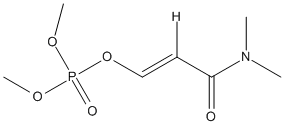Dicrotophos
Used to control sucking, boring, and chewing pests on rice, cotton, coffee, apples, and other crops. Effective on ornamentals, trees, and shrubs for aphids, leaf hoppers, and scale insects
General
Type : Organophosphate,Insecticide
Chemical_Nomenclature : [(E)-4-(dimethylamino)-4-oxobut-2-en-2-yl] dimethyl phosphate
Canonical SMILES : CC(=CC(=O)N(C)C)OP(=O)(OC)OC
InChI : InChI=1S\/C8H16NO5P\/c1-7(6-8(10)9(2)3)14-15(11,12-4)13-5\/h6H,1-5H3\/b7-6+
InChIKey : VEENJGZXVHKXNB-VOTSOKGWSA-N
Other name(s) : (E)-Phosphoric acid 3-(dimethylamino)-1-methyl-3-oxo-1-prophenyl dimethyl ester,(E)-3-(dimethylamino)-1-methyl-3-oxo-1-propenyl dimethyl phosphate,bidrin carbicron ektafos
MW : 237.21
Formula : C8H16NO5P
CAS_number : 141-66-2
PubChem : 5371560
UniChem : VEENJGZXVHKXNB-VOTSOKGWSA-N
IUPHAR :
Wikipedia : Dicrotophos

Target
References (3)
| Title : Recovery of brain and plasma cholinesterase activities in ducklings exposed to organophosphorus pesticides - Fleming_1981_Arch.Environ.Contam.Toxicol_10_215 |
| Author(s) : Fleming WJ |
| Ref : Archives of Environmental Contamination & Toxicology , 10 :215 , 1981 |
| Abstract : Fleming_1981_Arch.Environ.Contam.Toxicol_10_215 |
| ESTHER : Fleming_1981_Arch.Environ.Contam.Toxicol_10_215 |
| PubMedSearch : Fleming_1981_Arch.Environ.Contam.Toxicol_10_215 |
| PubMedID: 7224673 |
| Title : Ixodicidal resistance in Boophilus microplus (Canestrini) in the Republic of South Africa and Transkei - Baker_1979_J.S.Afr.Vet.Assoc_50_296 |
| Author(s) : Baker JA , Jordaan JO , Robertson WD |
| Ref : J S Afr Vet Assoc , 50 :296 , 1979 |
| Abstract : Baker_1979_J.S.Afr.Vet.Assoc_50_296 |
| ESTHER : Baker_1979_J.S.Afr.Vet.Assoc_50_296 |
| PubMedSearch : Baker_1979_J.S.Afr.Vet.Assoc_50_296 |
| PubMedID: 553968 |
| Title : Evaluation of cytotoxic responses caused by selected organophosphorus esters in chick sympathetic ganglia cultures - Obersteiner_1978_Can.J.Comp.Med_42_80 |
| Author(s) : Obersteiner EJ , Sharma RP |
| Ref : Can J Comp Med , 42 :80 , 1978 |
| Abstract : Obersteiner_1978_Can.J.Comp.Med_42_80 |
| ESTHER : Obersteiner_1978_Can.J.Comp.Med_42_80 |
| PubMedSearch : Obersteiner_1978_Can.J.Comp.Med_42_80 |
| PubMedID: 565668 |